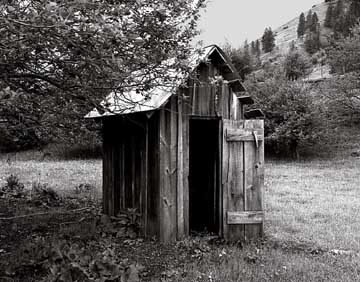“I use my tank’s flush system and it gets my tanks spotlessly clean!”
If we had a dime for every time we heard this, well, we’d no longer need to do tank cleanings! Almost every modern RV has some sort of flushing or rinsing system built into their tank. Their black tank, that is: Currently there is no RV manufacturer that includes a flushing or rinsing system as standard in their gray tanks.
So let’s take a look into what you likely have in your black tank, what some alternatives are, and why that system is probably not doing as good of a job as you think it is.
In-tank flushing
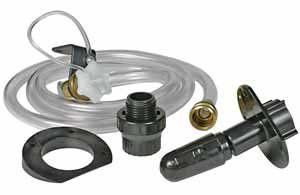 Many trailers have automatic black tank flushing systems, as do most motorhomes. Near your black tank, there should be a small valve that connects to a city water source, such as a garden hose. Connect a hose to this inlet, turn the water on and let the system do its work. The water is sprayed in all directions inside the tank.
Many trailers have automatic black tank flushing systems, as do most motorhomes. Near your black tank, there should be a small valve that connects to a city water source, such as a garden hose. Connect a hose to this inlet, turn the water on and let the system do its work. The water is sprayed in all directions inside the tank.
Manual flushing
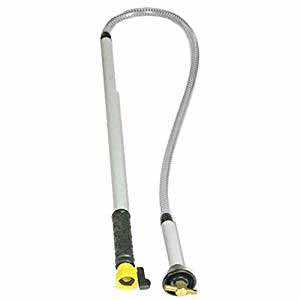 While automatic black tank flushing may be a necessary thing to do, it likely won’t be enough. Some RVers have asked us about manual black tank cleaning tools, such as a rinsing wand with a high-pressure head. This wand, when connected to your garden hose, can be placed down your RV’s toilet and give a secondary rinse to the tank to knock down any difficult-to-remove solids. There are a couple of versions — some with just a straight pipe and others that have a flexible length of hose on them.
While automatic black tank flushing may be a necessary thing to do, it likely won’t be enough. Some RVers have asked us about manual black tank cleaning tools, such as a rinsing wand with a high-pressure head. This wand, when connected to your garden hose, can be placed down your RV’s toilet and give a secondary rinse to the tank to knock down any difficult-to-remove solids. There are a couple of versions — some with just a straight pipe and others that have a flexible length of hose on them.
The good: Yes, this is better than not having anything. Applying some rinsing action from the “business” end of your holding tanks (especially the black tank via the toilet) can be beneficial to keeping your holding tanks cleaner. These are relatively inexpensive.
The bad: Oh, where to begin. First, you’ve got to get a water supply hose connected to one end of this contraption. That might mean a garden hose through an open window, snaking through a door and into your RV until you reach your bathroom, or using something like a Water Thief to capture water from a bathroom sink tap. Next, once you’re done, you’re carrying around in your RV something that has been down into or near your black tank. Who knows what’s on the end of that flush wand but we wouldn’t want it inside our RV! Finally, some RVs (like larger fifth wheels) have fairly lengthy drops and bends (fifth wheels and smaller travel trailers) between their toilet pipe and the black tank. You may not be able to reach the tank from inside the toilet in a lot of cases.
Other flushing options
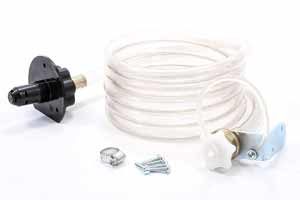 There are also some aftermarket flushing options like the Camco Quickie Flush. Intended to be mounted to the side of your holding tank (even the gray ones!) and pointed at the opening out to the sewer drain pipe, this attachment is yet another way to introduce fairly high-pressure water into your tanks to push out debris and solids.
There are also some aftermarket flushing options like the Camco Quickie Flush. Intended to be mounted to the side of your holding tank (even the gray ones!) and pointed at the opening out to the sewer drain pipe, this attachment is yet another way to introduce fairly high-pressure water into your tanks to push out debris and solids.
The good: These do a pretty good job of pushing waste out of your holding tanks. They are fairly inexpensive and better than not having any other option.
The bad: Depending on the layout of your tanks, whether there is a belly pan you may have to remove, and your comfort level with installing an unfamiliar system like this, this may not be a great option. We’ve read reports that addressing leaks may be an ongoing concern (especially at first) and some users really hesitated to work on their black tank considering what is likely lurking inside.
Backflushing
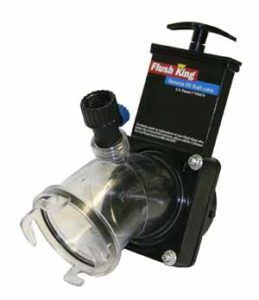 This is our favorite way to get BOTH your black and gray tanks clean. In fact, it’s our final step in performing our tank cleaning service. We use Valterra’s Flush King Back Flush Valve, a wonderful piece of technology that forces water back up into each of your holding tanks at a fantastic rate and with real power to clean and flush your tanks.
This is our favorite way to get BOTH your black and gray tanks clean. In fact, it’s our final step in performing our tank cleaning service. We use Valterra’s Flush King Back Flush Valve, a wonderful piece of technology that forces water back up into each of your holding tanks at a fantastic rate and with real power to clean and flush your tanks.
The good: The backflush valve can fill a 45-gallon holding tank in about four and a half minutes — roughly six times faster than you can by using your onboard rinse system — at typical RV park water pressure. Plus, the valve is transparent, so you can see what comes out of your tanks. The device also features a back check valve so anything coming out of your tanks can’t go back up the water supply line and into the park’s water supply system.
The bad: At roughly $60 to $75, the valve is a bit pricey. Also, the inlet valve does tend to leak after a year or so of use (we replace the rubber washer it came with a higher quality one).
In conclusion
As an RV owner, you have plenty of options when it comes to flushing your holding tanks. Yes, the built-in rinsing system in your black tank is a good step, but it’s not nearly enough to keep your tanks the healthiest they can be. Plus, your gray tanks don’t have this feature unless you add them in as an aftermarket option.
There’s still no replacement for having your holding tanks professional hydrojet-cleaned every year. A service like Kleen Tank (or one of our sister companies through All Pro Water Flow) is a smart investment for every RV owner.

